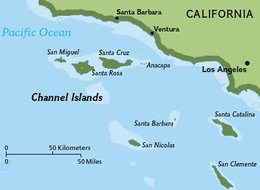Island Fox
|
|
| Island Fox Conservation status: Endangered | ||||||||||||||
|---|---|---|---|---|---|---|---|---|---|---|---|---|---|---|
| Missing image Urocyon_littoralis_full_figure.jpg Island Fox | ||||||||||||||
| Scientific classification | ||||||||||||||
| ||||||||||||||
| Binomial name | ||||||||||||||
| Urocyon littoralis (Baird, 1857) |
The Island Fox (Urocyon littoralis) is a small fox that is native to six of the eight Channel Islands of California. It is the smallest fox species in the United States. There are six subspecies of the fox, each unique to the island it inhabits, reflecting its evolutionary history. Other names for the Island Fox include Coast Fox, Short-Tailed Fox, Island Gray Fox, Channel Islands Fox, Channel Islands Gray Fox, California Channel Island Fox and Insular Gray Fox.
Golden Eagle predation, disease and human activities decimated fox numbers on several of the Channel Islands in the 1990s. Four Island Fox subspecies were federally protected as an endangered species in 2004, and efforts to rebuild fox populations and restore the ecosystems of the Channel Islands are being undertaken.
| Contents |
Taxonomy and evolution
The Island Fox shares the Urocyon genus with the mainland Gray Fox (Urocyon cinereoargenteus), the fox from which it is descended. Its small size is a result of island dwarfing, a kind of allopatric speciation.
Subspecies
There are six subspecies of Island Fox, each of which is native to a specific Channel Island, and which evolved there independent of the others. The subspecies are Urocyon littoralis littoralis of San Miguel Island, Urocyon littoralis santarosae of Santa Rosa Island, Urocyon littoralis santacruzae of Santa Cruz Island, Urocyon littoralis dickeyi of San Nicolas Island, Urocyon littoralis catalinae of Santa Catalina and Urocyon littoralis clementae of San Clemente Island. Foxes from each island are capable of interbreeding, but have genetic and phenotypic distinctions that make them unique; for example, the subspecies have differing numbers of tail vertebrae.
Evolution
The small size of the Island Fox is an adaptation to the limited resources available in the island environment. The foxes are believed to have "rafted" to the northern islands between 10,400 and 16,000 years ago.Template:Mn Initially fox populations were located on the three northern islands, which were likely to have been easier to access during the last ice age—when lowered sea levels united four of the northernmost islands into a single mega-island (Santa Rosae) and the distance between the islands and the mainland was reduced—it is likely that Native Americans brought the foxes to the southern islands of the archipelago, perhaps as pets or hunting dogs.Template:Mn
Based on the fossil record and genetic distance from their Gray Fox ancestors, the northern Island Foxes are probably the older subspecies, while the San Clemente Island Foxes have been only resident on their island for about 3,400–4,300 years, and the San Nicolas Island Foxes established themselves as an independent group about 2,200 years ago. The Santa Catalina Island Foxes are potentially the most recently evolved subspecies, having been on their island for about 800–3,800 years.Template:MnTemplate:Mn The foxes did not persist on Anacapa Island because it has no reliable source of fresh water; Santa Barbara Island is too small to support the food demands of the foxes.
Urocyon_littoralis_with_prey.jpg
Physical description
The Island Fox is much smaller than the grey fox, roughly the size of a house cat, and is the second smallest of all foxes after the Fennec. Typically the head-and-body length is 48–50 cm (18–20 in.), shoulder height 12–15 cm (4–6 in.), and the tail is 11–29 cm (4–11 in.) long, which is notably shorter than the 27–44 cm (10–17 in.) tail of the Gray Fox. Island foxes weigh between 1.3 and 2.8 kg (2.8–6.2 lb.). The male is always larger than the female.Template:Mn The largest of the subspecies occurs on Santa Catalina Island and the smallest on Santa Cruz Island.Template:Mn
The Island Fox has gray fur on its back, a ruddy red coloring on its sides, white fur on its belly, throat and the lower half of its face, and a black stripe on the dorsal surface of its tail.Template:Mn In general the coat is darker and duller hued than that of the Gray Fox. The Island Fox molts once a year between August and November. Before the first molt pups are woolly and have a generally darker coat than adult foxes.
Urocyon_littoralis_pup.jpg
Reproduction
Island Foxes typically form monogamous breeding pairs and are frequently seen together beginning in January and through the breeding season, from late February to early March. The gestation period is 33–50 days. The Island Fox gives birth in a den, a typical litter having one to five kits, with an average of two or three. Kits are born in the spring and emerge from the den in early summer; the mother lactates for 7–9 weeks. Sexual maturity is reached at 10 months, and the females usually breed within the first year. Island Foxes live for 4–6 years in the wild and for up to 8 years in captivity.Template:Mn
Ecology and behavior
Their preferred habitat is complex layer vegetation with a high density of woody, perennially fruiting shrubs. The foxes live in all of the island biomes including temperate forest and rainforest, temperate grassland and chaparral, with no island supporting more than 1,000 foxes. Island Foxes eat fruits, insects, birds, eggs, crabs, lizards and small mammals, including the deer mouse. The foxes tend to move around by themselves, rather than in packs. They are generally diurnal, albeit with peaks of activity at dawn and dusk. Activity also fluctuates with the season; they are more active during the day in summer than they are in winter.Template:Mn
Island foxes are not intimidated by humans, as they have historically been at the top of the island food chain and had no natural predators. They are quite easy to tame and are generally docile.Template:Mn Island foxes communicate with each other using auditory, olfactory and visual signals. A dominant fox uses vocalizations, staring and ear flattening to cause another fox to submit. They mark territory with urine and feces.
Decline
The decline in Island Fox populations was identified in the 1990s. On San Miguel Island the decline began in 1994, the adult population falling from 450 to 15 in 1999. Similar population declines were discovered on Santa Cruz Island where the population decreased from 2,000 adults in 1994 to less than 135 in 2000, and on Santa Rosa Island where 1,500 foxes recorded in 1994 were reduced to 14 animals by 2000.Template:Mn Golden Eagle predation, discovered when foxes were radiocollared and monitored, proved to be the cause of the high mortality rates.
Golden Eagle predation is the primary cause of Island Fox mortality. Golden Eagles were not known to live in the Channel Islands before the 1990s, and the first Golden Eagle nest was recorded on Santa Cruz Island in 1999.Template:Mn Biologists propose that the eagle may have been attracted to the islands by the expanding populations of feral livestock (such as pigs), as well as the decimation of the local Bald Eagle population due to DDT exposure in the 1950s—the bald eagles would have deterred the Golden Eagles from settling on the islands while they themselves subsisted on fish.Template:Mn
Introduced diseases or parasites can decimate Island Fox populations. Because Island Foxes are isolated they have no immunity to parasites and diseases brought in from the mainland and are especially vulnerable to those domestic dogs may carry. A canine distemper outbreak in 1998 killed approximately 90% of Santa Catalina Island's fox population.Template:Mn (It is difficult to vaccinate against or treat foxes for parasites and disease in the wild.)
Diminished food supply and general degradation of the habit due to introduced mammal species, including feral cats, pigs, sheep, goats and American Bison, the latter having been introduced to Catalina Island in the 1920s by a Hollywood film crew shooting a Western, also has had a negative effect on fox populations.
The foxes threaten a population of severely endangered loggerhead shrikes in residence on San Clemente Island. The Island Fox population on San Celmente Island has been negatively impacted by trapping and removal or euthanasia of foxes by the United States Navy. Since 2000, the Navy has employed different management strategies: trapping and holding foxes during the shrike breeding season, the installation of an electric fence system around shrike habitats, and the use of shock collar systems.Template:Mn Automobile fatalities have also been high on San Celmente, San Nicolas and Santa Catalina Islands.
Conservation
In March of 2004, four subspecies of the Island Fox were classified as a federally protected endangered species: the Santa Cruz Island Fox, Santa Rosa Island Fox, San Miguel Island Fox and the Santa Catalina Island Fox.Template:Mn The IUCN still lists them as "lower risk."
Caprive_breeding_Santa_Rosa_Island.jpg
The National Parks Service has initiated captive fox breeding programs on San Miguel, Santa Rosa and Santa Cruz Islands, successfully increasing the numbers of resident foxes. In 2004 there were 38 San Miguel Island Foxes, all in captivity; 46 foxes in captivity on Santa Rosa Island and 7 in the wild (Golden Eagle predation prevented the release of captive foxes into the wild); Santa Cruz Island had 25 captive foxes and a stable wild population of around 100 foxes.Template:Mn The Catalina Island Conservancy also runs a captive breeding program on Catalina Island; in 2002 there were 17 foxes in captive breeding programs and at least 161 wild foxes.Template:Mn
Key to the recovery of the Island Fox is the removal of the Golden Eagle from the Channel Islands, ecosystem restoration and disease control. To ensure survival of the Island Fox, Golden Eagles are being moved from the northern islands to the mainland. Maintaining and increasing the Bald Eagle population on the islands would help to displace the Golden Eagle. However, the program is extremely resource-intensive and is at risk for cancellation. Removal of feral pigs from Catilina Island and Santa Cruz Island is underway, removing both the golden eagles food and competition for the Island Fox. To eliminate the risk of disease, pets are not permitted in Channel Islands National Park. A vaccination program has been initiated to protect Catalina Island foxes from canine distemper.Template:Mn
Because the Channel Islands are almost entirely owned and controlled by either the Catalina Island Conservancy or the federal government, the fox has a chance to receive the protection it needs, including constant supervision by interested officials without the ongoing threat of human encroachment on its habitat.


